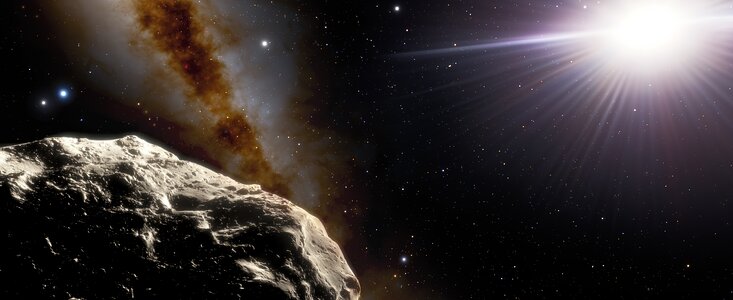

Un nuevo asteroide, enorme, en el vecindario
1 Febrero 2022
Un reciente descubrimiento ha despertado el interés de los astrónomos: usando el telescopio SOAR en Chile, un equipo de astrónomos ha visto el asteroide troyano de la Tierra más grande que se haya encontrado. Este tipo de asteroide está hecho de un material que data de la época del nacimiento de nuestro Sistema Solar y podría proporcionarnos pistas sobre los componentes básicos de nuestros planeta.
Podrías estar preguntándote qué son exactamente los asteroides troyanos. Este tipo de asteroides son compañeros, o ‘vecinos’, de un planeta, compartiendo la misma órbita de este planeta alrededor del Sol. Pueden estar ‘aparcados’ en un lugar donde la fuerza de gravedad que los atrae hacia el planeta y la del Sol que los aleja del planeta están en equilibrio - los llamados puntos de Lagrange.
En el caso de este asteroide específico, 2020 XL5, estamos hablando de un asteroide troyano de la Tierra, ya que es un compañero de nuestro planeta.
Es el segundo asteroide troyano encontrado hasta ahora y también el más grande que hayamos visto. 2020 XL5 tiene aproximadamente 1.2 kilómetros (0.73 millas) de diámetro, o unas tres veces tan ancho como 2010 TK7 , el primer asteroide de este tipo encontrado hace una década. 2010 TK7 tiene menos de 400 metros (o yardas) de diámetro, así que ¡puedes imaginarte lo grande que es 2020 XL5!
¿Y cómo descubrieron los astrónomos que 2020 XL5 es realmente un asteroide troyano terrestre y no simplemente un objeto cercano a la Tierra? El equipo utilizó datos anteriores del Sondeo de Energía Oscura para conocer la órbita del asteroide. Imágenes de 2012 y 2019 proporcionaron una mejor idea acerca de la trayectoria de 2020 XL5.
Los astrónomos piensan que no será un troyano para siempre: permanecerá estable donde se encuentra durante otros 4000 años más y al final se perderá hacia el espacio por perturbaciones gravitatorias.
Crédito de la imagen: NOIRLab/NSF/AURA/J. da Silva/Spaceengine. Agradecimiento: M. Zamani (NSF’s NOIRLab)
Dato curioso
Es posible que existan muchos más asteroides troyanos de la Tierra no detectados, ya que en el cielo se les ve cerca del Sol. Esta es la razón por la cual los astrónomos sugieren que el mejor momento para ‘observar’ o ‘buscar’ los troyano es alrededor del amanecer o del anochecer, con los telescopios apuntando cerca del horizonte. Para encontrar este, los astrónomos tuvieron que apuntar el telescopio SOAR muy bajo (¡solo 16 grados por encima del horizonte!) para poder ver 2020 XL5 al amanecer.
